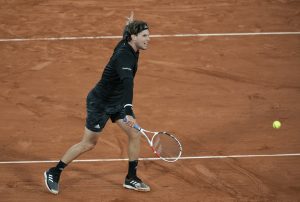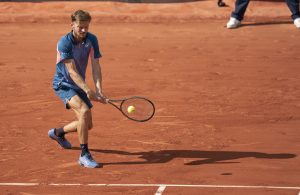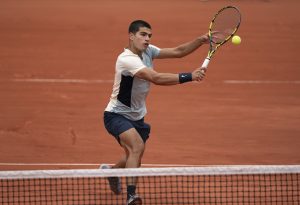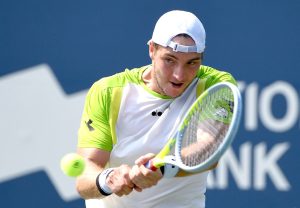Andrey Rublev established himself as one of the most promising NextGen players back in 2017. At just 19 years of age, he managed to clinch his maiden ATP title in Umag, having entered the draw as the lucky loser. He later backed it up with a stunning run to the quarterfinals at the US Open. The power of his forehand was absolutely devastating and it could single-handedly win matches for the Russian.
Soon, a back injury stopped him in his tracks and Rublev fell almost thirty spots in the ATP rankings to end 2018. Thankfully, it only took him a short while to get back on the right track and keep breaking new ground. That culminated in an absolutely brilliant 2020 campaign that had him win five titles on the main circuit (most of anyone) and lead the tour in matches won.
Rublev came up with a brilliant 41-10 win/loss record on the 2020 ATP Tour, winning all five finals he contested. Three of them were ATP 500 titles, Hamburg, St Petersburg, and Vienna. All that success allowed Rublev to break the top 10 for the very first time in October. Even though he also put up solid results during the Grand Slams (round 4 at the Australian Open; quarterfinalist at US Open and Roland Garros), these losses felt a bit disappointing given how dominant Rublev was in lower-tier events. With all the progress the Russian has made in the past two years or so, one question remains – can he contend for a Grand Slam in the near future?
Andrey Rublev
Rublev vs his contemporaries
An interesting stat to look at is his head-to-head records against his peers. Presuming Rublev will stay at the top for the remainder of his career, there’s a good chance he will have to take on Daniil Medvedev, Alexander Zverev, and Stefanos Tsitsipas a number of times throughout their careers. Tsitsipas is the youngest of the four but all were born between February 1996 and August 1998. With the “Big 4 (3?)” era about to finish, it won’t be Rafael Nadal or Novak Djokovic making it so hard to contend for Grand Slams anymore. A new generation of players is approaching and to win on the biggest stages, Rublev will have to face (and beat) them often.
Rublev has faced Daniil Medvedev four times on the professional circuits. Dating back to their 2016 meeting at the Budapest Challenger, the two have already contested nine sets between each other. All of them were taken by Medvedev, most in a rather comfortable fashion. Between Zverev, Tsitsipas, and Medvedev, his compatriot seems like the toughest matchup for the 23-year-old. The amazing rally tolerance and fantastic defending keep making Rublev overhit and look for the winner too early. There are some silver linings though as their 2020 US Open meeting was by far the closest one, with two sets requiring tie-breakers. Rublev was actually willing to engage in very long rallies and quite often came out as the victor. This matchup should also improve thanks to the development of the Russian’s serve.
His matchup against Alexander Zverev has been just as troublesome. Rublev lost all the nine sets he contested against the German and only made it to a single tie-breaker. Zverev handed the Russian another one of his 2020 Grand Slam losses, in the fourth round of the Australian Open. Rublev was coming off two consecutive title weeks in Doha and Adelaide and despite the negative head-to-head record, he was considered a slight favorite to win that clash. But yet again, Alexander Zverev was able to defend well enough to force out errors and respond with big plays of his own.
Stefanos Tsitsipas is by far the most comfortable opponent of the three for Rublev. Their head-to-head stands tied at 3-3, following two wins for the Greek and one for the Russian in 2020. Rublev took their Hamburg championship match as Tsitsipas failed to serve out the match and completely went away mentally to hand the Russian two breaks in a row. Just 11 days later, they met again in the quarterfinals of the French Open. After a rather brilliant and incredibly tight final in Hamburg, the expectations were understandably sky-high and everyone expected a classic. But once again, Rublev disappointed as the Grand Slam event was reaching its latter stages. The Russian was only competitive for a set in a straightforward 5-7 2-6 2-6 loss.
[pickup_prop id=”4821″]
The most important shot in tennis?
How does 2021 Rublev differ from the raw talent that the public was introduced to at Umag 2017? The biggest and perhaps most pivotal improvement is in his serve. Four years ago, the Russian won over 80% of points on first serve in just 11 out of 65 matches we have detailed stats from. In 2020, this number skyrocketed all the way up to 30 out of 51. Both his placement and power have massively progressed to a point where Rublev is probably among the best (first) servers on the tour right now. There’s no need to talk about how important getting free points, starting the rallies from an attacking position, or being able to hit the forehand as the first shot after the serve is in modern tennis.
Another big issue in the past was the second serve, clocking at a really low speed and basically without much spin, making it an easy target. Coming back to the number for a second, Rublev won 50% or less of his 2nd serve points in 36 out of 65 matches in 2017. It shouldn’t come as a surprise that in 67% of these cases he would walk off the court defeated. By 2020, there were only 17 such cases in 51 instances. It’s only a testament to Rublev’s stunning form overall that he still managed to win 12 of them. None were as extreme as the 2019 Cincinnati loss to Medvedev or the 2017 US Open loss to Nadal when Rublev didn’t win even 30% of his second serve points. The moonball from the past has transformed into a solid, reliable kick serve that doesn’t hand over the initiative to the opponent.
On top of that, there are many smaller things that have taken a massive turn for the better. Footwork, stamina, the timing of his open stance shots played on the slide. Rublev is also taking a lot more risk on return, allowing himself to start the all-out attack earlier in the rally. The Russian has a lot more confidence to step into his weaker backhand wing and use it as a way to set up the inside-in or inside-out forehands. The latter is really an ever-dangerous shot, mixing incredible power with consistency like Juan Martin Del Potro’s hammer stroke back in the day.
Who can take out Rublev?
One lower-ranked player that seems to have found the recipe to beat Rublev is Dan Evans. The Brit won two out of three at the expense of the current World No. 8 last year, somehow managing to mitigate the power difference. Evans uses a unique all-court style and has one of the best backhand slices in the game, which allows him to completely mix up the rhythm of play from the ground and come forward to the net. It sounds easy on paper but there is hardly anyone on the tour with a similar skillset to the Brit and even fewer players that could make it work against Rublev in his current form.
The aforementioned Daniil Medvedev might soon be standing in Rublev’s way again at the Australian Open. The Russians are projected to meet in the quarterfinals at the Australian Open. The reportedly fast conditions should give Rublev a better shot than at the US Open. It’s been an absolutely spectacular start to the year from both as they coupled to win the ATP Cup for their country. Rublev and Medvedev were undefeated in singles action, winning four matches apiece. If he is to break through the quarterfinal stage at a Grand Slam for the very first time, he might have to solve the riddle sooner than expected.
Main Photo:
Embed from Getty Images






